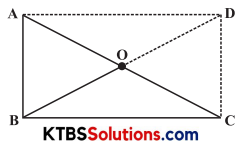You can Download KSEEB Solutions for Class 8 Maths Chapter 3 Understanding Quadrilaterals Ex 3.4 Questions and Answers helps you to revise the complete syllabus.
KSEEB Solutions for Class 8 Maths Chapter 3 Understanding Quadrilaterals Ex 3.4
Question 1.
State whether True or False:
- All rectangles are squares.
- All rhombuses are parallelograms.
- All squares are rhombuses and also rectangles.
- All squares are not parallelograms.
- All kites are rhombuses.
- All rhombuses are kites.
- All parallelograms are trapeziums.
- All squares are trapeziums.
Solution:
- False
- True
- True
- False
- False
- True
- True
- True
![]()
Question 2.
Identify all the quadrilaterals that have.
- four sides of equal length.
- four right angles.
Solution:
- The quadrilateral is either a Rhombus or a Square.
- The quadrilateral is either a Square or a Rectangle.
Question 3.
Explain how a square is.
- a quadrilateral
- a parallelogram
- a rhombus
- a rectangle
Solution:
- A square is a four-sided closed figure, so it is a quadrilateral.
- In a square, both pairs of opposite sides are equal. Hence, it is a parallelogram.
- A square is a rhombus because all sides of a square are equal.
- A square is a rectangle because its opposite sides are equal and all angles are 90° each.
![]()
Question 4.
Name the quadrilaterals whose diagonals.
- bisect each other.
- are perpendicular bisectors of each other.
- are equal.
Solution:
- The diagonals of a parallelogram, rectangle, rhombus and square bisect each other.
- The diagonals are perpendicular bisectors in squares and rhombus.
- The diagonals are equal in square and rectangle.
Question 5.
Explain why a rectangle is a convex quadrilateral.
Solution:
Both of its diagonals lie in its interior.
![]()
Question 6.
ABC is a right-angled triangle and O is the midpoint of the side opposite to the right angle. Explain why O is equidistant from A, B, and C. (The dotted lines are drawn additionally to help you).

Solution:
OB is produced to D such that OB = OD
Join AD and CD.
Now, ABCD is quadrilateral whose diagonals AC and BD bisect each other at O.
So, O is equidistant from A, B and C.